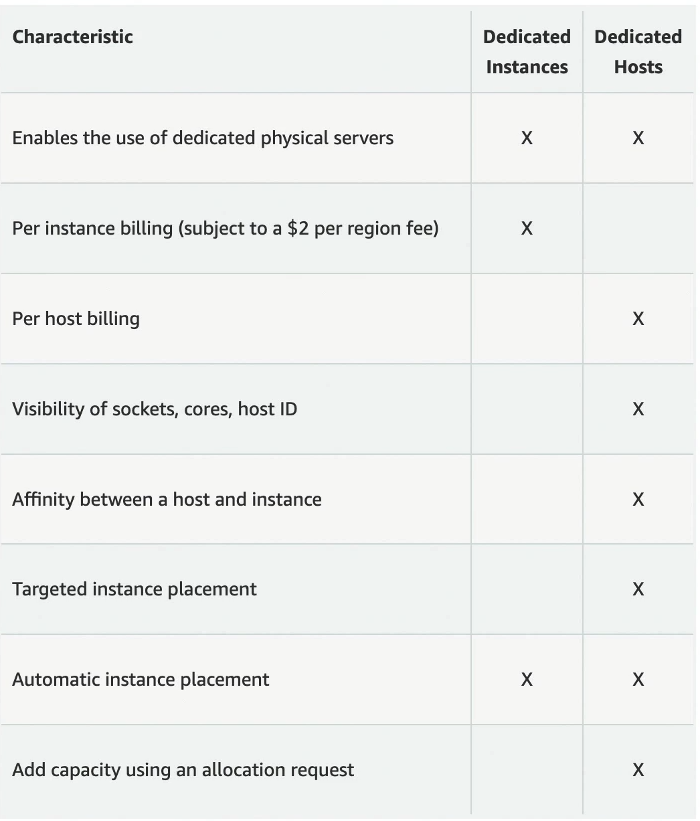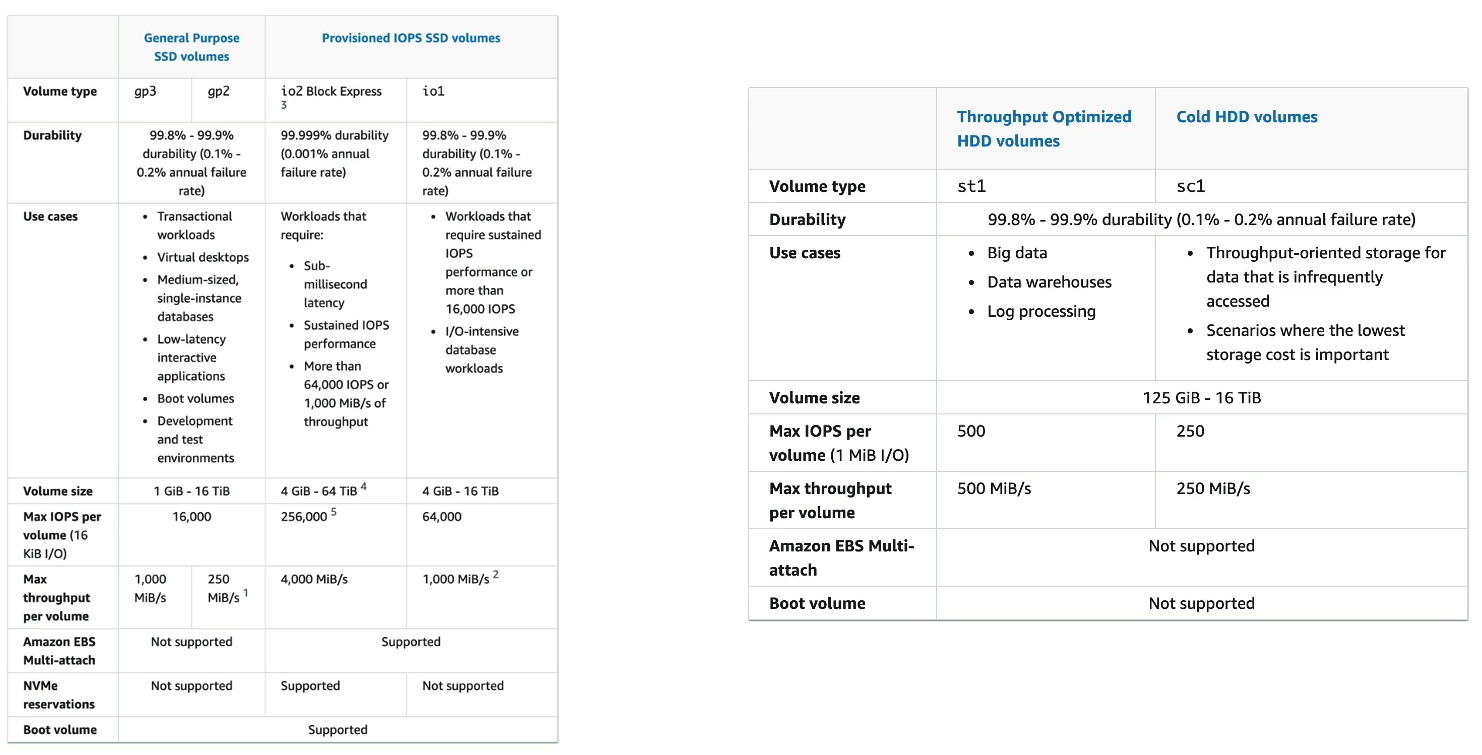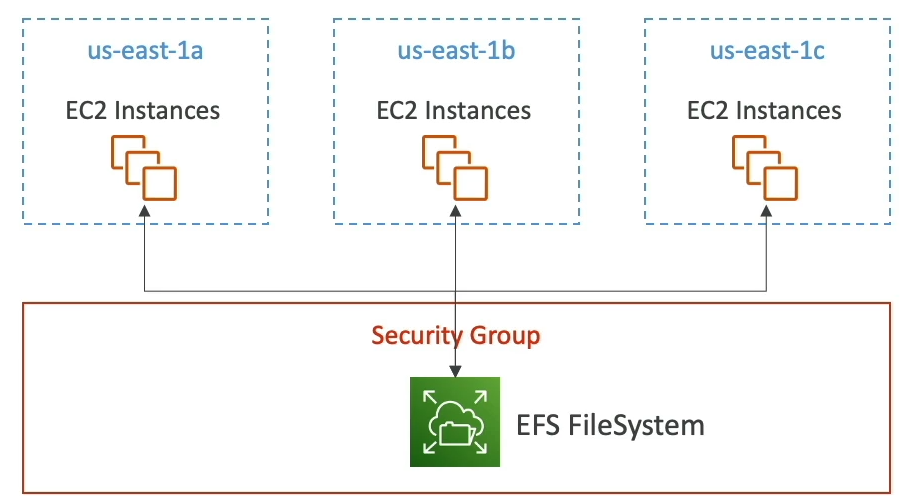Amazon EC2 (AWS Certified Solutions Architect - Associate)
 Rohit Pagote
Rohit PagoteEC2 Basics
EC2 = Elastic Compute Cloud
Infrastructure as a Code (IaaS) service.
It mainly consists in the capability of:
Renting Virtual Machines (EC2)
Storing data on virtual drives (EBS)
Distributing load across machine (ELB)
Scaling the services using an auto-scaling group (ASG)
EC2 sizing & configuration options
OS: Linux, Windows & MacOS
How much compute power and cores (CPU)
How much random-access memory (RAM)
How much storage space:
Hardware (EC2 instance store)
Network-attached (EBS & EFS)
Public IP address
Firewall rules: Security Groups
Bootstrap script (configure at first launch only): EC2 user data
EC2 User Data
It is possible to bootstrap the instances using an EC2 User Data Script.
Bootstrapping means launching or running command when a machine starts.
This script is only run once at the instance first start.
EC2 user data can be used to automate boot tasks such as:
installing updates
installing softwares
downloading common files from the internet, etc.
EC2 user data script runs with the root user.
EC2 Instance Types
Will add aws skill builder link here to read for the ec2 instance types.
AWS has the following naming convention:
m5.2xlarge
m: instance class
5: generation (AWS improves them over time)
2xlarge: size within the instance class (CPU, Memory, etc.)
Below mentioned some of the most used instance types.
EC2 Instance Type - General Purpose
Great for a diversity of workloads such as web servers or code repositories.
Provide balance between:
Compute
Memory
Networking
EC2 Instance Type - Compute Optimized
Great for compute intensive tasks that require high performance processors.
Batch processing workloads
Media transcoding
High performance web severs
High performance computing (HPC)
Scientific modeling & machine learning
Dedicated gaming servers
EC2 Instance Type - Memory Optimized
Fast performance for workloads that process large data sets in memory (RAM).
High performance, relational/non-relational databases
Distributed web scale cache stores
In-memory databases optimized for BI (Business Intelligence)
Applications performing real-time processing of big unstructured data
EC2 Instance Type - Storage Optimized
Great for storage intensive tasks that require high, sequential read and write access to large data sets on local storage.
High frequency online transaction processing (OLTP) systems
Relational and NoSQL databases
Cache for in-memory databases (ex. Redis)
Data warehousing applications
Distributed file systems
Security Groups (SG)
Introduction
SG are the fundamental of network security in AWS.
They control how traffic is allowed into or out of EC2 instances.
SG only contain allow rules.
SG rules can reference by IP or by Security group.
Deeper Dive
SG acts as a firewall on EC2 instances.
They regulate:
Access to ports
Authorized IP ranges - IPv4 or IPv6
Control of inbound network (from other to the instance)
Control of outbound network (from the instance to other)
Good to know
SG can be attached to multiple instances.
Locked down to a region/VPC combination. (if you switch a region or create a new VPC, you have to create new SG)
Does live outside the EC2 - if traffic is blocked, the EC2 instance won't see it.
It's good to maintain one separate SG for SSH access.
If your application is not accessible (time out), then its a SG issue.
If your application gives a "connection refused" error, then its probably an application issue.
All inbound traffic is blocked by default.
All outbound traffic is allowed by default.
Classic Ports to Know
22 = SSH (Secure Shell) - log into Linux instance
21 = FTP (File Transfer Protocol) - upload files into a file share
22 = SFTP (Secure File Transfer Protocol) - upload files using SSH
80 = HTTP - access unsecured websites
443 = HTTPS - access secured websites
3389 = RDP (Remote Desktop Protocol) - log into a Windows instance
EC2 Instance Purchasing Options
On-Demand Instances: short workload, predictable pricing, pay by second
Reserved (1 & 3 years):
Reserved Instance: long workloads
Convertible Reserved Instance: long workloads with flexible instances
Saving Plans (1 & 3 years): commitment to an amount of usage, long workload
Spot Instance: short workloads, cheap, can lose instances anytime (less reliable)
Dedicated Hosts: book an entire physical server, control instance placement
Dedicated Instances: no other customer will share your hardware
Capacity Reservations: reserve capacity in a specific AZ for any duration
EC2 On Demand
Pay for what your use:
Linux or Windows - billing per second, after the first minute.
All other operating systems - billing per hour.
Has the highest cost but no upfront payment.
No long-term commitment.
Recommended for short-time and un-interrupted workloads, where you can't predict how the application will behave.
EC2 Reserved Instances
Up to 72% discount compared to on-demand.
You reserve a specific instance attributes (Instance type, Region, Tenancy, OS).
Reservation Period - 1 year (+ discount) or 3 years (+++ discount).
Payment options -No upfront (+), Partial upfront (++), All upfront (+++).
Reserved Instances' scope - Regional or Zonal (reserve capacity in an AZ).
Recommended for steady-state usage applications (like database).
You can buy and sell in the Reserved Instances Marketplace if it is no more needed.
Convertible Reserved Instances
Can change the EC2 instance type, instance family, scope, OS and Tenancy.
Up to 66% discount.
EC2 Savings Plans
Get a discount based on long-term usage (up to 72% - same as RIs).
Commit to a certain type of usage ($10/hour for 1 or 3 years).
Usage beyond EC2 Savings Plans is billed at the On-Demand price.
Locked to a specific instance family and AWS region (ex: M5 in us-east-1).
Flexible across:
Instance size (ex: m5.xlarge, m5,2xlarge).
OS (ex: Linux, Windows).
Tenancy (Host, Dedicated, Default).
EC2 Spot Instances
Can get a discount of up to90% compared to On-Demand.
Instances that you can lose at any point of time if your max price is less than the current spot price.
Define max-spot price and get the instance while current spot price < max.
The hourly spot price varies based on offer and capacity
If the current spot price > your max price, you can choose to stop or terminate your instance with a 2 minutesgrace period.
The most cost-efficient instances in AWS.
Useful for workloads that are resilient to failure:
Batch jobs
Data analysis
Image processing
Any distributed workloads
Workloads with a flexible start and end time
Not suitable for critical jobs or databases.
EC2 Dedicated Hosts
A physical server with EC2 instance capacity fully dedicated to your use.
Allows you address compliance requirements and use your existing server-bound software licenses (per-socket, per-core, per-VM software licenses).
Purchasing options:
On-Demand - pay per second for active Dedicated Host
Reserved - 1 or 3 years (No upfront, Partial upfront, All upfront)
The most expensive options in AWS.
Useful for software that have complicated licensing model (BYOL - Bring Your Own License).
For companies that have strong regulatory or compliance needs.
EC2 Dedicated Instances
Instances run on hardware that's dedicated to you.
May share hardware with other instances in same account.
No control over instance implement (can move hardware after stop/start).
Dedicated Hosts VS Dedicated Instances

EC2 Capacity Reservations
Reserved On-Demand instances capacity in a specific AZ for any duration.
You always have access to EC2 capacity when you need it.
No time commitment (create/cancel anytime), no billing discounts.
Combine with Regional Reserved Instances and Savings Plans to benefit from billing discounts.
You're charged at On-Demand rate whether you run instances or not.
Suitable for short-time, un-interrupted workloads that need to be in a specific AZ.
Spot Fleets
Spot Fleets = set of Spot Instances + (optional) On-Demand Instances.
The Spot Fleet will try to meet the target capacity with price constraints.
Define possible launch pools: instance type (m5.large), OS, availability zone.
Can have multiple launch pools, so that the fleet can choose.
Spot Fleet stops launching instances when reaching capacity or max cost.
Strategies to allocate Spot Instances:
lowestPrice: from the pool with the lowest price (cost optimization, short workload)
diversified: distributed across all pools (great for availability, long workloads)
capacityOptimized: pool with the optimal capacity for the number of instances
priceCapacityOptimized (recommended): pools with highest capacity available, then select the pool with the lowest price (best choice for most workloads)
Spot Fleet allow us to automatically request Spot Instances with the lowest price.
Public IP VS Private IP (IPv4)
Networking has two sorts of IPs. IPv4 and IPv6.
IPv4: 1.160.10.240
IPv6: 1900:4545:3:200:f8ff:fe21:67cf
IPv4 is still the most common format used online.
Ipv6 is newer and solves problems for the Internet of Things (IoT).
IPv4 allows for 3.7 billion different addresses in the public space.
IPv4: [0-255].[0-255].[0-255].[0-255]
Difference between Public IP and Private IP
Public IP:
Public IP means the machine can be identified on the internet (www).
Must be unique across the whole web (not two machines can have the same public IP).
Can be geo-located easily.
Private IP:
Private IP means the machine can only be identified on a private network only.
The IP must be unique across the private network.
But two different private networks (two companies) can have the same IPs.
Machines connect to www using an internet gateway (a proxy).
Only a specified range of IPs can be used as private IP.
Elastic IP
When you stop and then start the EC2 instance, it can change its public IP.
If you need to have a fixed public IP for your instance, you need an Elastic IP.
An Elastic IP is a public IPv4 IP you own as long as you don't delete it.
You can attach it to one instance at a time.
With an Elastic IP address, you can mask the failure of an instance or software by rapidly remapping the address to another instance in your account.
You can only have 5 Elastic IP in your AWS account (you can ask AWS to increase that).
Overall, try to avoid using Elastic IP:
They often reflect poor architectural decisions.
Instead, use a random public IP and register a DNS name to it.
Or use a Load Balancer and don't use a public IP.
EC2 Placement Groups
Sometimes you want control over the EC2 instance placement strategy.
That strategy can be defined using placements groups.
When you create a placement group, you specify one of the following strategies for the group:
Clusters - clusters instances into a low-latency group in a single AZ.
Spread - spreads instances across underlying hardware (max 7 instances per group per AZ) - critical applications
Partition - spreads instances across many different partitions (which rely on different sets of racks) within an AZ. Scales to 100s of EC2 instances per group (Hadoop, Cassandra, Kafka).
Placement Group - Cluster
Pros: Great network (10 Gbps bandwidth between instances with enhanced networking enabled - recommended).
Cons: If the AZ fails all instances fails at the same time.
Use case:
Big data jobs that needs to complete fast.
Applications that needs extremely low latency and high network throughput.
Placement Group - Spread
Pros:
Can span across AZs
Reduced risk of simultaneous failure.
EC2 instances are on different physical hardware.
Cons:
- Limited to 7 instances per AZ per placement group.
Use case:
Application that needs to maximize high availability.
Critical applications where each instance must be isolated from failure from each other.
Placement Group - Partition
Up to 7 partitions per AZ.
Can span across multiple AZs in the same region.
Up to 100s of EC2 instances.
The instances in a partition do not share racks with the instances in the other partitions.
A partition failure can affect many EC2 but won't affect other partitions.
EC2 instances get access to the partition information as metadata.
Use case: HDFC, HBase, Cassandra, Kafka.
Elastic Network Interfaces (ENI)
Logical component in a VPC that represents a Virtual Network Card.
The ENI can have the following attributes:
Primary private IPv4, one or more secondary IPv4
One Elastic IP (IPv4) per private IPv4
One public IPv4
One or more security groups
A MAC address
You can create ENI independently and attach them on the fly (move them) on EC2 instances for failover.
Bound to a specific availability zone (AZ).
EC2 Hibernate
We know we can stop, terminate instances
Stop - the data on disk (EBS) is kept intact till the next start.
Terminate - any EBS volumes (root) also set-up to be destroyed is lost.
On start, the following happens:
First start: the OS boots and the EC2 User Data script is run.
Following starts: the OS boots up.
Then your application starts, caches get warmed up, and that can take time.
Introducing EC2 Hibernate:
They in-memory (RAM) state is preserved.
The instance boot is much faster (the OS is not stopped or restarted).
Under the hood: the RAM state is written to a file in the root EBS volume.
For this, the root EBS volume must be encrypted and it must have enough space to contain the RAM.
Use Case:
Long-running processes
Saving the RAM state
Services that takes time to initialize
EC2 Hibernate - Good to know
Supported instance families - C3, C4, C5, I3, M3, M4, R3, R4, T2, T3, etc.
Instance RAM size - must be less than 150 GB.
Instance size - not supported for bare metal instances.
AMI - Amazon Linux 2, Linux AMI, Ubuntu, RHEL, CentOS and Windows, etc.
Root volume - must be EBS, encrypted, not instance store and large.
Available for On-Demand, Reserved and Spot instances.
An instance can not be hibernated for more than 60 days.
EC2 Storage
EBS Volume
EBS stands for Elastic Block Store.
An EBS volume is a network drive you can attach to your instances while they run.
It allows your instances to persist data, even after their termination.
One EBS volume can be mounted to one instance but some "multi-attach" feature is also available for some EBS.
Free Tier: 30 GB of free EBS storage of type General Purpose (SSD) or Magnetic per month.
It's a network drive (not a physical drive).
It uses the network to communicate the instance, which means there might be a bit of latency.
It can be detached from an EC2 instance and attached to another one quickly.
They are bound to a specific availability zone.
An EBS volume in us-east-1a cannot be attached to us-east-1b.
To move a volume across, you first need to snapshot it.
Have a provisioned capacity (size in GBs, and IOPS).
You get billed for all the provisioned capacity.
You can increase the capacity of the drive over time.
EBS - Delete on Termination attribute
We have an attribute in EBS called as Delete on Termination.
It controls the EBS behavior when an EC2 instance terminates:
By default, the root EBS volume is deleted (attribute enabled)
By default, any other attached EBS volume is not deleted (attribute disabled)
This can be controlled by the AWS Console / AWS CLI.
Use case: preserve root volume when instance is terminated.
EBS Snapshots
Make a backup (snapshot) of your EBS volume at any point in time.
Not necessary to detach volume to do snapshot, but recommended.
Can copy snapshots across AZ or Region.
EBS Snapshots Features
EBS Snapshot Archive
Move a snapshot to an 'archive tier' that is 75% cheaper.
Takes within 24 to 72 hours for restoring the archive.
Recycle bin for EBS Snapshots
Setup rules to retain deleted snapshots so you can recover them after an accidental deletion.
Specify retention (1 day to 1 year).
Fast Snapshot Restore (FSR)
Force full initialization of snapshot to have no latency on the first use.
It is very costly.
AMI
AMI - Amazon Machine Image.
AMI are a customization of an EC2 instance.
You add your own software, configuration, operating system, monitoring, etc.
Faster boot/configuration time because all your software is pre-packaged.
AMI are build for a specific region (and can be copied across regions).
You can launch EC2 instance from:
Public AMI: AWS provided
Your own AMI: you make and maintain them yourself
AWS Marketplace AMI: an AMI someone else made (and potentially sells)
AMI Process (from an EC2 instance)
Start an EC2 instance and customize it.
Stop the instance (for data integrity).
Build an AMI - this will also create EBS snapshots.
Launch instances from other AMIs.

EC2 Instance Store
EBS volumes are network drives with good but limited performance.
If you need a high performance hardware disk, use EC2 instance store.
It has better I/O performance.
EC2 instance store lose their storage if they're stopped (ephemeral).
Good for buffer/cache/scratch data/temporary content.
Risk of data loss if hardware fails.
Backups and Replications are your responsibility.
EBS Volume Types
EBS volumes come in 6 types:
gp2 / gp3 (SSD): General purpose SSD volume that balances price and performance for a wide variety of workloads.
io1 / io2 Block Express (SSD): Highest performance SSD volume for mission-critical low-latency or high-throughput workloads.
st1 (HDD): Low cost HDD volume designed for frequently accessed, throughput-intensive workloads.
sc1 (HDD): Lowest cost HDD volume designed for less frequently accessed workloads.
EBS volumes are characterized in Size | Throughput | IOPS.
Only gp2/gp3 and io1/io2 Block Express can be used as boot volumes.
EBS volume types - General Purpose SSD
Cost effective storage, low-latency.
System boot volumes, virtual desktops, development and test environments.
Storage vary from 1GB - 16TB.
gp3:
Baseline of 3000 IOPS and throughput of 125 Mbps.
Can increase IOPS up to 16,000 and throughput up to 1000 Mbps independently.
gp2:
Small gp2 volumes can burst IOPS to 3000.
Size of the volume and IOPS are linked, max IOPS is 16,000.
3 IOPS per GB, means at 5334 GB we are at the max IOPS.
EBS volume types - Provisioned IOPS (PIOPS) SSD
Critical business applications with sustained IOPS performance.
Or applications that need more than 16,000 IOPS.
Great for database workloads (sensitive to storage performance and consistency).
io1 (4GB - 16TB):
Max PIOPS: 64,000 for Nitro EC2 instances and 32,000 for other.
Can increase PIOPS independently from storage size.
io2 Block Express (4GB - 64TB):
Sub-millisecond latency.
Max PIOPS: 256,000 with an IOPS: GB ratio of 1000:1
Supports EBS Multi-attach.
EBS volume types - Hard Disk Drives (HDD)
Cannot be a boot volume.
Storage vary from 125 GB - 16 TB.
Throughput Optimized HDD (st1):
Big data, Data warehouses, Log processing.
Max throughput 500 Mbps - max IOPS 500.
Cold HDD (sc1)
For data that is infrequently accessed.
Scenario where lowest cost is important.
Max throughput 250 Mbps - max IOPS 250.

EBS Multi-attach - io1/io2 family
Attach the same EBS volume to multiple EC2 instances in the same AZ.
Each instance has full read and write permissions to the high-performance volume.
Use case:
Achieve higher application availability in clustered Linux application (ex: Teradata).
Applications must manage concurrent write operations.
Can attach to up to 16 instances at a time.
Must use a file system that's cluster-aware (not XFS, EXT4, etc.).
EBS Encryption
When you create an encrypted EBS volume, you get the following:
Data at rest is encrypted inside the volume.
All the data in flight moving between the instance and the volume is encrypted.
All the snapshots are encrypted.
All volumes create from snapshots are encrypted.
Encryption and decryption are handled transparently.
Encryption has a minimal impact on latency.
EBS encryption leverages keys from KMS (AES-256).
Copying an unencrypted snapshot allows encryption.
Snapshots of encrypted volumes are encrypted.
Snapshots created from unencrypted EBS volume is also unencrypted.
Encryption: encrypt an unencrypted EBS volume
Create an EBS snapshot of the volume.
Encrypt the EBS snapshot (using copy).
Create new EBS volume from the snapshot (the volume will also be encrypted).
Now you can attach the encrypted volume to the original instance.
Amazon EFS
EFS stands for Elastic File System.
Managed NFS (Network File System) that can be mounted on many EC2.
EFS works with EC2 instances in Multi-AZ.
It is highly-available, scalable, expensive (3*gp2), pay per use.

Use case: content management, web serving, data sharing, Wordpress.
Uses NFSv4.1 protocol.
Uses security group to control access to EFS.
Compatible with Linux based AMI (not Windows).
Can enable encryption at rest using KMS.
POSIX file system (~Linux) that has a standard file API.
File system scales automatically, pay per use, no capacity planning.
EFS - Performance
EFS Scale
1000s of concurrent NFS clients, 10GB+/s throughput.
Grow to petabyte-scale network file system, automatically.
Performance Mode (set at EFS creation time)
General purpose (default) - latency-sensitive use case (web server, CMS, etc.)
Max I/O - higher latency, throughput, highly parallel (big data, media processing).
Throughput Mode
Bursting - 1TB = 50Mbps+ burst of up to 100Mbps.
Provisioned - set your throughput regardless of storage size, ex: 1Gbps for 1TB of storage.
Elastic - automatically scales throughput up or down based on your workloads.
Up to 3Gbps for reads 1Gbps for writes.
Used for unpredictable workloads.
EFS - Storage Classes
Storage Tiers (lifecycle management features - move file after N days)
Standard: for frequently accessed files.
Infrequent Access (EFS-IA): cost to retrieve files, lower cost to store the files.
Archive: rarely accessed data (few times a year), 50% cheaper.
Implement lifecycle policies to move files between storage tiers.
Availability and Durability
Standard: Multi-AZ, great for production.
One Zone: One AZ, great for dev, backup enabled by default, compatible with IA (EFS One Zone-IA).
Overall, by using the right EFS storage classes, you can do up to 90% in cost savings.
EBS VS EFS
Elastic Block Storage (EBS)
EBS volumes...
attach to one instance (except multi-attach io1/io2).
are locked at the Availability Zone (AZ) level.
gp2: IO increases if the disk size increases.
gp3 and io1: can increase IO independently.
To migrate an EBS volume across AZ:
Take a snapshot.
Restore the snapshot to another AZ.
EBS backups use IO and you shouldn't run them while your application is handling a lot of traffic.
Root EBS volumes of instances get terminated by default if the EC2 instance gets terminated (can disable that).
Elastic File Storage (EFS)
Mounting 100s of instances across AZ.
EFS shares website files (Wordpress).
Only for Linux instances (POSIX).
EFS has a higher price point than EBS.
Can leverage storage tiers for cost savings.
Subscribe to my newsletter
Read articles from Rohit Pagote directly inside your inbox. Subscribe to the newsletter, and don't miss out.
Written by

Rohit Pagote
Rohit Pagote
I am an aspiring DevOps Engineer proficient with containers and container orchestration tools like Docker, Kubernetes along with experienced in Infrastructure as code tools and Configuration as code tools, Terraform, Ansible. Well-versed in CICD tool - Jenkins. Have hands-on experience with various AWS and Azure services. I really enjoy learning new things and connecting with people across a range of industries, so don't hesitate to reach out if you'd like to get in touch.